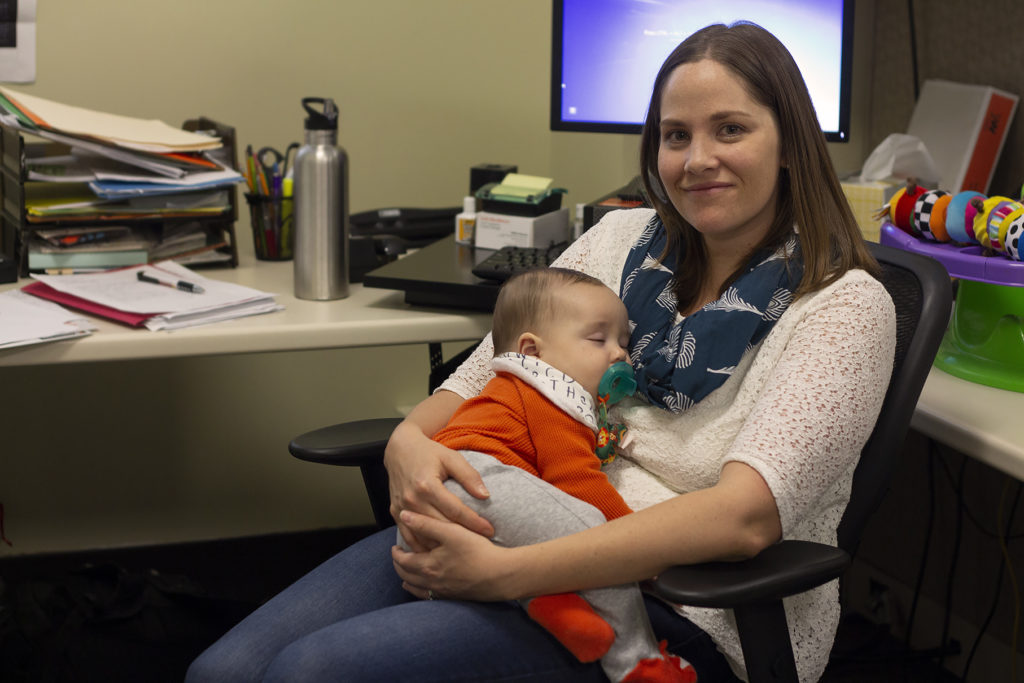YW Boston employees can bring their babies to work and here’s why other workplaces should consider it too

In May of 2018, YW Boston chose to implement an Infant-At-Work program as part of our official policies. As an organization dedicated to racial and gender equity, we recognize the importance of providing innovative childcare solutions and the impact these practices can have on retaining women in the workforce.
Last month, YW Boston said goodbye to our first Infant-At-Work participant, baby Jameson, in a bittersweet office retirement party. While we will surely miss little Jameson’s gummy smile and energetic bouncing, we look forward to providing our employees with the option of benefiting from this program after its first successful run.
How does an Infant-At-Work program operate?
Although companies will customize their own Infant-At-Work policies based on their needs, many use the resources provided by the Parenting in the Workplace Institute as a guideline. These stipulate that eligible employees can bring their infant to work from ages four weeks to 4-6 months, or until the child becomes mobile, whichever occurs first. Infant-At-Work programs are voluntary options for employees and are subject to approval by an organization’s leadership team. They are not intended to replace regular childcare arrangements for employees, but rather foster the development of the employee/child bond during the infant’s early life while maintaining an efficient and productive workplace.
What are the considerations for bringing a baby to work?
- An employee’s job responsibilities must be compatible with and allow for taking care of the baby at work
- The workplace environment and the employee’s job responsibilities allow for a safe environment for the infant
- Parents must select two employees who are able and willing to provide back-up care
- Diapers must not be changed in work areas
- The employee must maintain an acceptable work performance and ensure that the presence of the infant does not create any office disturbances
- Eligibility may be suspended or terminated at any time
 What are the benefits of an Infant-At-Work program?
What are the benefits of an Infant-At-Work program?
- Earlier return to work after a baby’s birth
- Increased employee engagement and retention
- Increased collaboration and teamwork
- Increased efficiency from parent participants
- A competitive edge for companies looking to attract more diverse candidates
The potential benefits for organizations implementing Infant-At-Work programs are vast. Particularly for small and medium-sized companies who cannot compete with the benefits offered by larger ones. Allowing new parents to care for their babies at work typically does not result in increased costs for the company. Parents are responsible for acquiring any materials necessary to make their individual workspaces baby-friendly. Additionally, an Infant-At-Work policy is a cheaper alternative to extended parental leaves or employer-provided daycare.
We interviewed our Senior Manager of Special Projects, Julia MacMahon to learn more about her experience bringing baby Jameson to work. Julia is an advocate for the Infant-At-Work Program and shared some advice for parents interested in proposing similar policies at their workplaces.
YW Boston: Let’s start at the beginning, how did you go about proposing the idea of an Infant-at-Work policy to your employer [YW Boston]?
Julia MacMahon: “I have a friend who works at a nonprofit who did this at her job. Prior to that, I had never heard of such a policy. Pretty soon after I was pregnant, I started thinking about the possibility of doing this at YW Boston. Once I told Beth [YW Boston President & CEO] and the office that I was pregnant, I asked if this was something they would be open to. So, I wrote up a policy proposal and sent it to our leadership team. They had a couple of edits, they approved it, and it was sent around through HR. Our Director of Operations gave folks an opportunity to raise any concerns. There were maybe a couple of questions, but everything was really straightforward. I think people were mainly excited about it. I like to think of Jameson as a little morale boost. And I think the leadership team saw it as an opportunity for us to live our mission of empowering women.”
 YW: Companies that offer Infant-At-Work programs report organizational benefits such as increased employee satisfaction, positive press, and shorter employee parental leaves. What has been the impact of this policy for you as a parent, on an individual level?
YW: Companies that offer Infant-At-Work programs report organizational benefits such as increased employee satisfaction, positive press, and shorter employee parental leaves. What has been the impact of this policy for you as a parent, on an individual level?
JM: “Definitely the extra bonding time. This is such a formative time in Jameson’s development. And also, for me, in my development as a new mom. This program made it a lot easier for me to be able to breastfeed fulltime and not supplement with formula. Pumping is really hard, time-consuming, and expensive. I hear this from a lot of women when they go back to work. They have to give up on breastfeeding or breastfeeding exclusively because of how hard it is to do as a working mom. In fact, studies often cite early return to work as one of the reasons for premature termination of breastfeeding. So, on days when Jameson was here at work, I didn’t have to pump. I just fed him like I normally would at home. There are a lot of decisions you make as a mom that are influenced by outside pressures, such as going back to work. The [Infant-At-Work] policy helped me feel like work is more amenable to supporting me and helping me make the decisions that are best for me and my baby.”
YW: How did your family respond to the news that you could bring your baby to work?
JM: “All the responses have been positive. I often get asked, ‘Where do you work that lets you do that?’ Especially among other parents of young babies. They are super impressed and wish their jobs would do that.”
YW: What about the reception at the workplace, here at YW Boston?
JM: “Folks loved having a baby around. It’s funny because the policy states that you have to pick two people who will provide backup care. This means that they will keep an eye on the baby if I need to go to the bathroom or am in a meeting where I really can’t have him there. Yet the majority of the office wanted to hold or watch the baby. So, in reality, I easily had ten people I could turn to for assistance.”
YW: What advice would you offer parents who are about to take part in an Infant-At-Work program?
JM: “Ease in– It’s helpful to ease in when coming back to work. When I first came back, I did so on my own so that I could get myself settled into the office and into the work. After that, I started taking one day off with Jameson and coming in with him for slightly shorter days until I was able to come back full-time.
Have a plan but be flexible with it– Take advantage of the opportunity to work from home, if you have it. That’s another great thing we have at YW Boston, the flexibility of being able to work from home. I was using my FMLA (Family and Medical Leave Act) time to take some days off in the beginning and working from home during others. Figure out what works for you.
Make your space baby-friendly– My cubicle turned into what I call a ‘nursicle’ or ‘cubery.’ I got some privacy blinds so I could feed him at my desk instead of having to go to a different room. I turned my cubicle into a nice little world with his playmat and bright toys. Everything I had was either a hand-me-down or something I got for free online. I also got a mini fridge which was great for those days when I was pumping so I could keep a bottle for him.”

Little Jameson leading a staff meeting
YW: Do you bring the baby to meetings?
JM: “Not to meetings with folks from outside YW Boston. Although I have brought him to meetings with volunteers and once to an interview with a participant from our Youth Leadership Initiative. Generally, what I tried to do was to plan outside meetings when he was in daycare. I would bring him to internal meetings with YW Boston staff and people loved having Jameson there. If at some point he started to cry, I would bounce him until he calmed down. And sometimes he would start to have little happy baby moments and I would say ‘Wait ya’ll, can we take a little happy baby break?’ Which then become a thing. It has been fun to see him interact with different people and build those relationships. It has really helped bring out the social side of him. Bringing him to work let me connect with folks in a different way through my baby.”
YW: What about concerns from other co-workers who might have their productivity affected by the presence of a baby?
JM: “That is covered by the way the policy is written and by a midpoint check-in. And if at any point someone feels like it’s a distraction, they can go to HR and accommodations can be made to address those concerns. If accommodations don’t work, I would have then found childcare for the baby. It’s all about communication. The policy states that if the baby starts crying, the parent has to take the baby outside. Overall, I wanted to make this program work for everyone, so I was particularly mindful of Jameson.”
 YW: How would you address those who argue that the workplace is not a safe place for a baby?
YW: How would you address those who argue that the workplace is not a safe place for a baby?
JM: “Technically, every place can be dangerous for a baby, even your home. Eligible parents will baby-proof their workplace before the baby is brought to work. Most importantly, not all workplaces or job positions are compatible with an Infant-At-Work policy, the program stipulates specific considerations for eligibility.”
YW: What would you say to others who argue that bringing a baby to work demonstrates a lack of professionalism?
JM: “It’s a legitimate concern, but we should engage in a larger conversation about what professionalism means and who is defining it. The workforce is made up of millions of parents. Is it unprofessional to recognize parenthood as a part of their identity and develop ways to support them in the workplace? This consideration is particularly important for companies looking to attract and retain more women, given that the division of domestic labor is still unequal, and women are often the ones who have to make the decisions between work or baby. Combine racial and gender pay gaps with the ‘motherhood penalty’—an occurrence where after becoming fathers, men see a 6% increase in earnings while new mothers see a 4% decrease per child—and you will find a landscape that impacts women in the workplace, particularly women of color with children. And I’m talking about my perspective on this as a woman and as a mother because that’s my experience, but Infant-At-Work policies are for any parent no matter their gender identity. I would love it if my husband had the kind of job where he could take the baby to work once a week. He would love it. He misses the baby. Sometimes he gets home from work and the baby is already asleep.”
YW: What would you say to those who suggest that parents should just put their baby in childcare?
JM: “We recognize that some can’t afford that. Some parents have to go back to work after only two weeks. That means they have to buy formula and pay for daycare. Those costs add up. It’s part of many factors that reinforce cycles of poverty which particularly impact women of color. I think it’s important for me to recognize that, as a white woman who even has this opportunity. And it’s something I try not to take for granted. Whether a parent can afford daycare or not, that’s not necessarily the point. The physicality of being with your baby all day is so important. There is so much research around its importance for a baby’s development. Babies need to hear adults talk. Infant-At-Work programs are part of a benefits package. It’s a perk and helps people feel like they are working at an organization that values and supports them.”
– – –
The challenges faced by working parents intersect with gender, class, and race, and should not be observed in isolation. Women of color and black mothers already face larger wage gaps and higher rates of single motherhood. In fact, Black women are 2.5 times more likely to be single mothers than white women. Historically, white mothers have been able to get closer to obtaining work-life balance thanks to the domestic labor performed by women of color. Women of color, in particular, are disproportionately compelled into situations where they have to choose between time, money, and parenting.
If companies want to retain diverse candidates, they have to recognize the importance of implementing policies and practices that recognize the unique challenges faced by women, people of color, and particularly women of color. According to a recent comparison of policies across two dozen countries, it was access to affordable, reliable childcare–not flexible hours or parental leave–that played the biggest role in closing the gender wage gap and ensuring that new mothers could remain in the workforce.
If you are interested in implementing an Infant-At-Work program at your workplace, explore these additional resources:
New Hampshire company, W.S. Badger has been supporting Babies at Work for 10 years via The Boston Globe
Washington State Department of Health establishes an Infant at Work Program on July 2015
Parenting in the Workplace Institute

—
About YW Boston
As the first YWCA in the nation, YW Boston has been at the forefront of advancing equity for over 150 years. Through our three programs—Dialogues, LeadBoston, and InIt—as well as our advocacy work, we help individuals and organizations create more inclusive environments where women, people of color, and especially women of color can succeed.
Join our mailing list
Sign up to receive our monthly newsletter, The Leader, as well as special news and invitations to YW Boston events.
